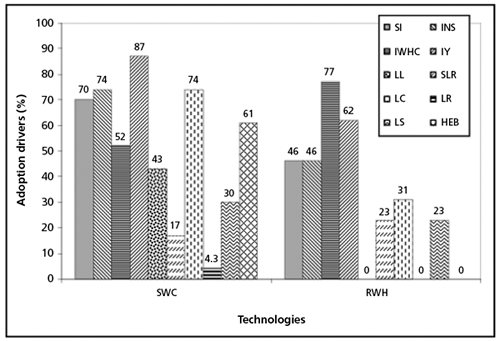Introduction
In sub-Saharan Africa (SSA), especially in the Sudano-Sahelian zone, the current level of dependency on irrigated land is very low and rainfed agriculture plays the central role in sustaining rural livelihoods and meeting food requirements. The challenge in this region is to optimize crop production per drop of rain. The arid and semi-arid zones (SARZ) of SSA (Map 1) cover about 41 percent of SSA and are characterized by low, erratic rainfall (300–600 mm per annum), and infertile soils which are crust-prone. In this zone, most of the land area is under rainfed agriculture and only two percent is irrigated. Much of the population in the semi-arid zone is still facing chronic under-nutrition and food insecurity due to high seasonal and yearly variability in food supplies, often as a result of the aforementioned factors as well as man-made catastrophes. In the semi-arid zone (especially the rural savanna zone), poverty and food insecurity are interlinked and widespread in rural areas and have a strong bias with regard to the natural resource endowment (water, good soils and vegetation). Land and water degradation, overgrazing, slash and burn practices, have led to food shortages and to significant environmental degradation. According to most experts, a sound and comprehensive approach based on the conservation of water and soil fertility for balanced and sustained agricultural production system is a basis for improved food security in the sub-region.

Communal stone rows laying.
Field level Technologies
Research on better use of runoff through a system of tillage has been reported to rejuvenate soil surface structures. Indigenous and adapted technologies of rain water harvesting (RWH) and soil water conservation (SWC) have been shown to offer potentials for reducing runoff and soil loss, rehabilitating degraded lands and improving available soil moisture and nutrients. In an attempt to evaluate the impact of these technologies on poverty alleviation and improvement in livelihoods, a workshop on Water Conservation Technologies for Sustainable Dryland Agriculture in SSA organized by IWMI and FAO was conducted in 2003 with the aim of documenting these technologies, ascertain their geographical spread in Sub-Saharan Africa and identify the adoption drivers/constraints.
In the semi-arid zone of West Africa, two of these technologies, stone-rows (Photo) and Zaï/tassa pits have been reported to be the most widespread in the region. An on-farm experiment on RWH, stone rows, was conducted at Kirsi village, northwest of Burkina Faso. Results from the experiment showed that as stone row spacing decreases, soil moisture content (top and sub-soil) increased as did grain and biomass yields.
At Saria (Burkina Faso), results from a single or combined soil water conservation measures (SWC) showed that grain yields from treatments with compost + Urea are higher than with solely Urea and the control. Economic analysis conducted on selected treatments such as stone rows or grass strips with or without compost or urea, and combinations showed that the treatment with stone rows +compost (SRC) has higher economic benefit compared to other treatments.

Agro-ecological zones of SSA.
Results from reviewing several documented SWC technologies by experts during the Workshop showed that 75 percent of these technologies have been verified, disseminated and adopted, 10.7 percent tested and verified, and 14.3 percent have not been adopted at all. Regarding documented RWH technologies, results showed that 61.9 percent has been verified, disseminated and adopted while 14.3 percent have been tested and verified.
Adoption drivers for SWC and RWH are summarized in Figure as being soil improvement (SI), improved nutrient status (INS), improved water holding capacity (IWHC), increased yield (IY), low labour (LL) costs, secure land rights (SLR), low capital costs (LC), low risks (LR), low skill acquisition (LSA), and high ecological benefits (HEB). Highest adoption drivers for RWH technologies, are IWHC>IY >SI & INS. Similarly, the highest adoption drivers for SWC technologies are HY>INS&LC>SI.

Adoption drivers for selected technologies.
Conclusion
Under erratic and apparently dwindling rainfall conditions in the semi arid zone of SSA, major contributions to crop production improvement can be anticipated from improved and up-scaled SWC and RWH conservation measures. It is only by fostering and improving these technologies in a sustainable way that the risk of drought, crop failure and ecological refugees could be minimized. Technology adoption by farmers is crucial to increasing agricultural productivity hence meeting food and nutrition is a great challenge in Africa.
For more information contact:
Dr. Boubacar BARRY
[email protected]
Dr. Adesola Olaleye
[email protected]
Dr.Adetola Adeoti
[email protected]